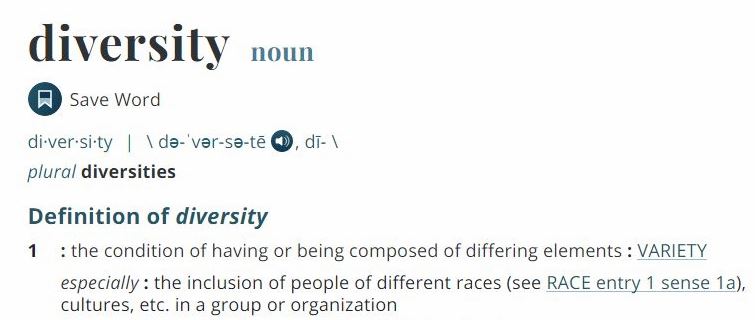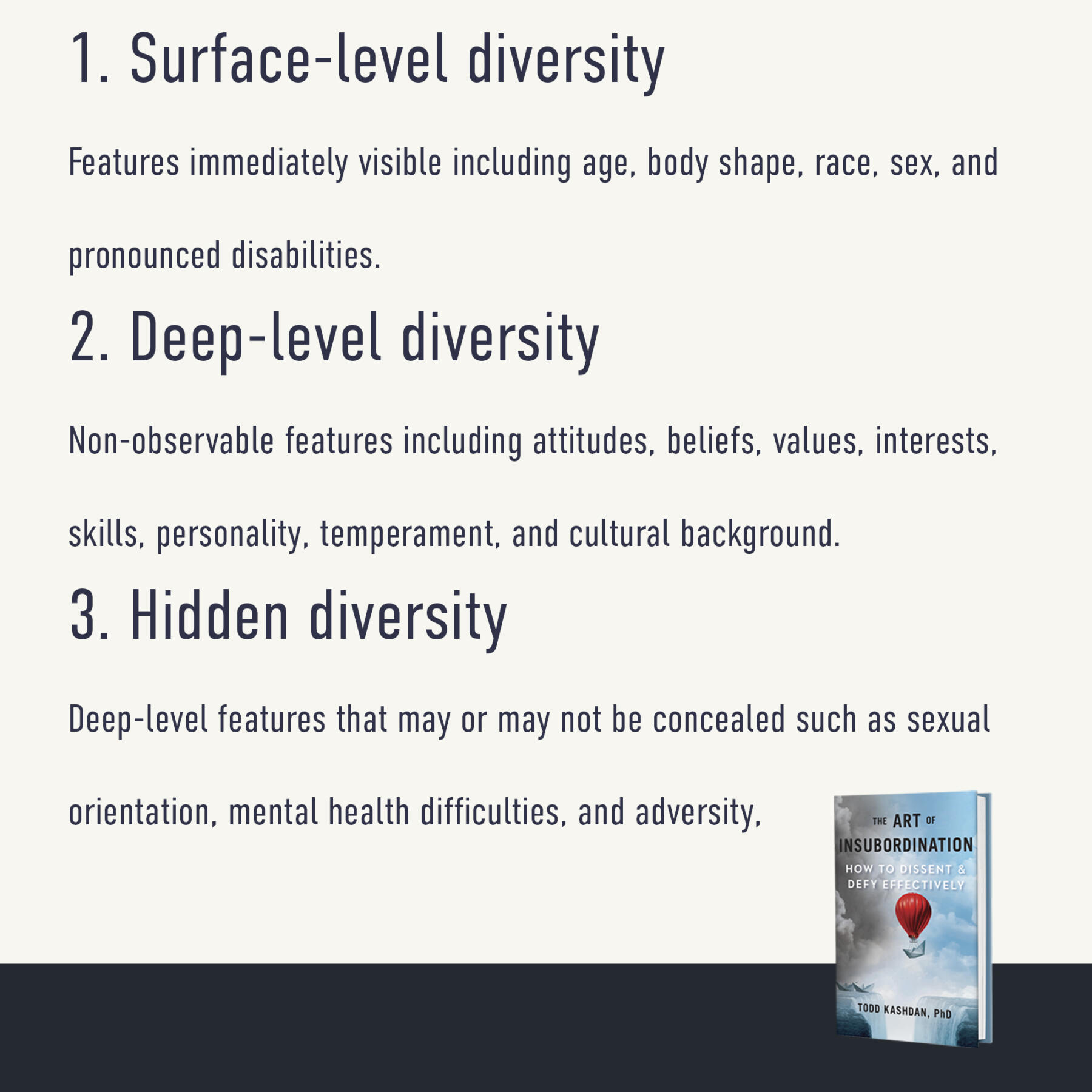Rethinking Diversity Discussions and Initiatives
Diversity interventions often fail. To increase support for diversity, permit and embrace open, honest communications. It starts with the definition. Which individual differences count, which are discounted, and why? It starts with identifying the exact intervention targets. Successful initiatives are guided by principles for how to respond to situations that arise again and again.
Narrow Definitions
Nearly every university and large organization in America has released a diversity statement.
The vast majority of knowledge workers offer public declarations supporting diversity. But it appears to be limited to a very specific set of demographics and ideological positions.
Much of the national dialogue revolves around race, sex, gender, and sexual orientation. Definitions from dictionaries, such as Merriam-Webster, index only one especially important category of diversity – race. Which is surprising because a vast number of dimensions of differences exist, and the value of any feature depends on the relevance to the group’s mission.

Do not be mislead into thinking classifying individuals into categories is simple. Consider at least three categories of diversity and a large number of interacting individual differences that lie underneath.

Consider less appreciated examples of diverse individuals who lack sufficient political mobilization. Diverse individuals who are often harmed by the dominant social order in classroom and organizational settings.
-
Someone on the autism spectrum – who finds it hard to grasp implicit cultural rules of what is socially acceptable.
-
A recent immigrant – who lacks social capital accrued over generations and finds it hard to fit in.
-
People with a shy or inhibited temperament – who are less prone to speaking up in group settings because they experience fewer rewards in the spotlight.
-
An adult who decides not to have kids – unintentionally penalized by workplace support for childcare.
-
Ageism remains widely acceptable. So much so, that in 2021, a software company gained an edge by mentioning in a job ad, “we hire old people.”
No Surprise – We’re Attracted to People Like Us
It is hard to embrace people different from ourselves. A well-established similarity – attraction effect exists, where initial encounters are more desirable with people who look like us, think like us, act like us, and share common interests, skills, and values. To be more precise, it’s our assumption that people are similar to us that determines whether we like someone, not whether they are actually similar. Across 313 laboratory and field studies, whether it is reading a job application, looking at a photograph of a potential conversation partner, or meeting a stranger, whether we think someone is similar to us is the biggest determinants of acceptance/rejection.
There is benefit in moving up a level in diversity discussions to address more than race, sex, gender, sexual orientation, and political ideology. Consider the law of attraction to similar folks and frequent repulsion to dissimilar folks. Consider the preference for low maintenance interactions when it requires small amounts of energy to understand and interact with someone. We mistake ease as a proxy for cultural fit.
Top-Down Directives Backfire
One reason diversity initiatives fail is the demand for compliance instead of collaboration. An honest discussion should take place about the hoped for outcomes of diversity initiatives. Consider three reasons for increasing diversity. First, to undue historical wrongdoings. Second, to increase representation. Third, to improve some desirable outcome that results from diversity such as learning, growth, performance, creativity, and better decision-making. It could be any combination of these three.
Regardless of the reason for seeking diversity, to gain advocates and traction, embrace the process of building a healthy culture.
There will be conflict.
There will be dissenting views.
None of this is automatically problematic.
How you manage conflict and dissenting views matters.
10 Principles for Difficult Conversations
Groups benefit from a framework for difficult conversations. And it is difficult to discuss the nature of diversity, benefits and tradeoffs of pursuing diversity, evidence for and against the presence of diversity problems, possible interventions for diversity problems, and methods for evaluating the effectiveness of diversity interventions. Read the list of 10 Principles below. Infuse them into the culture of your classroom, group, or organization. Share the list with others.
NOTE: Download a PDF version of the 10 principles here.
-
The Illusory Danger Principle. If you can think of a question, you can ask it. The only dangerous question is the belief that dangerous questions exist.
-
The Benevolent Intention Principle. Encourage others to speak by letting them know that you will work hard to react with charity, curiosity, and the assumption of positive intent. When speaking, you should receive the same receptivity unless there is incontrovertible evidence to suggest otherwise.
-
The Likability Principle. Reduce the impact of how much you like or dislike people when it comes to making judgments about the content of their messages and how you treat them. Know that likability is often irrelevant to the legitimacy of ideas. We must separate the message from the messenger.
-
The Individual Differences Principle. Resist treating individuals as representatives of their groups. There is often more heterogeneity within groups than between groups.
-
The Open-Minded Principle. Balance the pressures for conformity with a willingness to explore alternative ideas and perspectives. Remember that being open and curious does not imply any commitment to changing views.
-
The Broad Diversity Principle. Broaden definitions of diversity to go beyond what is visible to include categories of class and socioeconomic status, adversity, neurodiversity, and individual differences in temperament and personality. Remember that attracting diverse individuals is pointless unless you do the harder part of working with them, valuing and encouraging their uniqueness.
-
The Ad Hominem Principle. Resist the temptation to label people as simply “bad” or sexist, racist, homophobic, elitist, an ideologue, a snowflake or the like. Instead, engage in the more nuanced task of grappling with the quality of their ideas and solutions.
-
The Independent Thinking Principle. Be aware of cognitive biases that afflict everyone, especially confirmation bias and motivated reasoning. Hold the same standards for evidence whether it agrees or disagrees with your initial and preferred positions.
-
The Behavioral Evidence Principle. Rely on evidence as much as possible, even if this leads toward answers that conflict with your assumptions and preferences.
-
The Personal Evolution Principle. Each person must commit to learning and growing. This means being willing to let go of ideas that are no longer working or that fail to survive empirical scrutiny.
It feels satisfying to assume everyone is on the same page about diversity and yet in the absence of questions and dissenting views, failure is almost assured.
Create a culture where diversity can be addressed – both the problems and the promises. How information is gathered and interpreted matters. The process of how decisions are made matters. Foster an environment that addresses systematic biases in the investigative process for the sake of finding and implementing the best solutions.
Know someone interested in diversity? Share these Provoked ideas with them!

Dr. Todd B. Kashdan is the author of The Art of Insubordination: How to Dissent and Defy Effectively (Avery/Penguin) and is a Professor of Psychology and leads The Well-Being Laboratory at George Mason University.